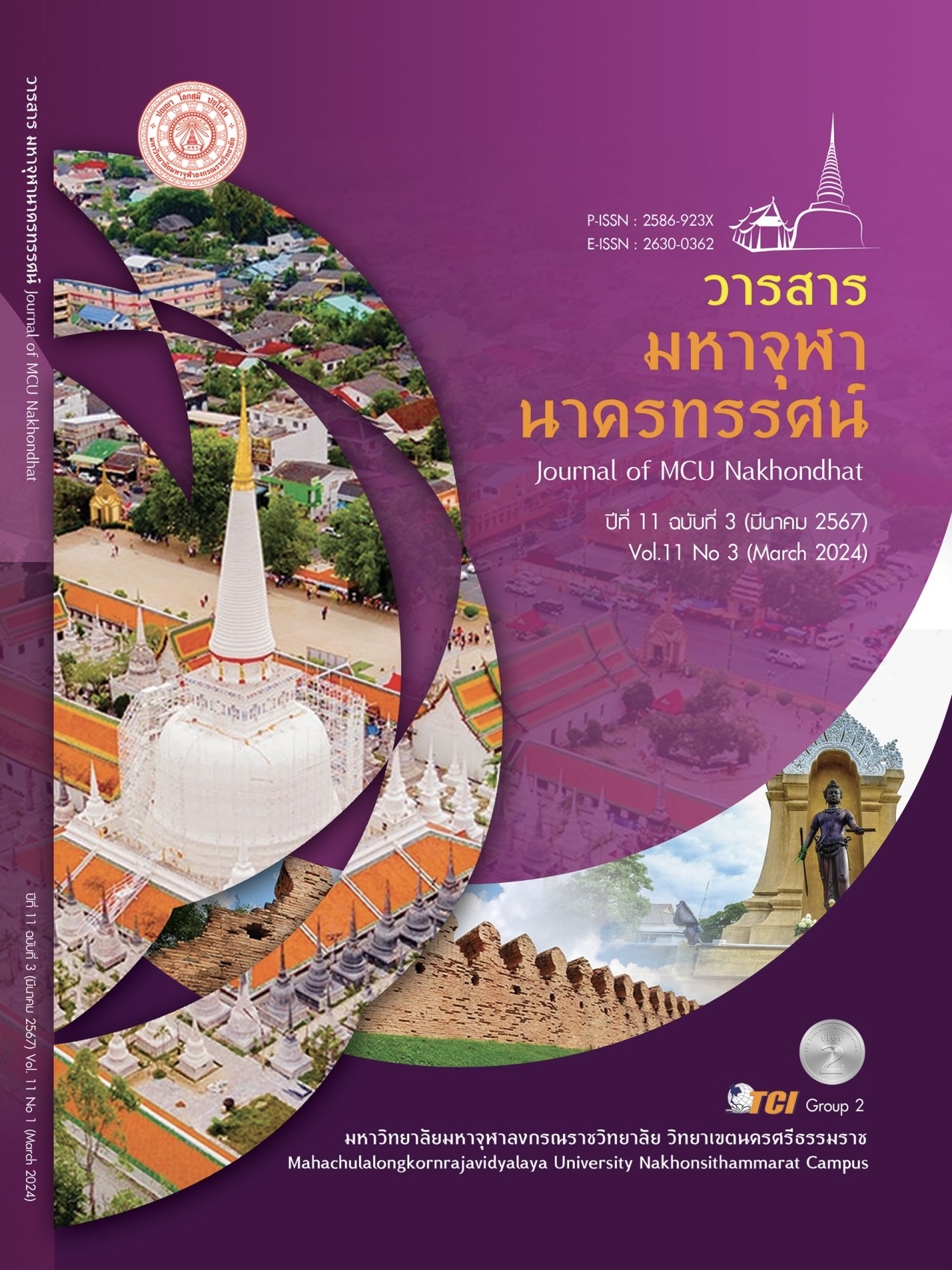ADOPTION OF AUGMENTED REALITY TECHNOLOGY AND COSMETICS PURCHASE BEHAVIOR AMONG FEMALE CONSUMERS
Main Article Content
Abstract
The objectives of this research are to Perception of ease, perceived benefits, and perceived risks of augmented reality (AR) technology. Acceptance of AR technology. Purchasing behavior of cosmetics through online platforms. The influence of perceived ease, perceived benefits, and perceived risks on the acceptance of AR technology. And The influence of acceptance of AR technology on cosmetics purchasing behavior through online platforms. This is a quantitative research with a sample group of female consumers aged 18 and above, who are interested in cosmetics products and are members of a Facebook cosmetics group, totaling 400 people. Data was collected using questionnaires, and statistical analysis included frequency, percentage, mean, standard deviation, and simple regression analysis (SRA). The research found that the sample group perceived ease at the highest level with an average score of 4.39, perceived benefits at the highest level with an average score of 4.40, perceived risks at a moderate level with an average score of 2.70, acceptance of AR technology at a high level with an average score of 3.71, and cosmetics purchasing behavior through online platforms at a frequent level with an average score of 4.01. The analysis of hypotheses revealed that perceived ease and perceived benefits significantly influence the acceptance of AR technology at a statistical significance level of 0.05. Acceptance of AR technology significantly influences cosmetics purchasing behavior through online platforms at a statistical significance level of 0.05, while perceived risks do not significantly influence the acceptance of AR technology.
Article Details

This work is licensed under a Creative Commons Attribution-NonCommercial-NoDerivatives 4.0 International License.
References
เกวรินทร์ ละเอียดดีนันท์. (2559). การยอมรับเทคโนโลยีด้านการรับรู้ถึงความเสี่ยงมีผลต่อการตัดสินใจซื้อหนังสืออิเล็กทรอนิกส์ของผู้บริโภคในเขตกรุงเทพมหานคร. ใน วิทยานิพนธ์บริหารธุรกิจมหาบัณฑิต สาขาวิชาบริหารธุรกิจ. มหาวิทยาลัยกรุงเทพ.
เกียรติภูมินา ควรรณกิจ. (2564). การยอมรับเทคโนโลยีความเป็นเอกลักษณ์และการรับรู้ความเสี่ยงที่ส่งผลต่อการตัดสินใจใช้แอปพลิเคชั่น TikTok. ใน วิทยานิพนธ์บริหารธุรกิจมหาบัณฑิต สาขาวิชาบริหารธุรกิจ. มหาวิทยาลัยกรุงเทพ.
ญาตาวี ทิพย์เที่ยงแท้. (2565). อิทธิพลของเทคโนโลยีความจริงเสริมที่มีต่อความตั้งใจซื้อสินค้ากลุ่มเครื่องสำอางผ่านทัศนคติต่อเทคโนโลยี. ใน วิทยานิพนธ์การจัดการมหาบัณฑิต สาขาการจัดการ. มหาวิทยาลัยมหิดล.
ธงชัย ชลศิริพงษ์. (2561). ทําไม L’Oreal แบรนด์เครื่องสําอางรายใหญ่ของโลก ต้องซื้อกิจการบริษัท เทคโนโลยี AI/AR. เรียกใช้เมื่อ 19 ธันวาคม 2566 จาก https://brandinside.asia/ loreal-ai-ar-technology/
พิชญาภา นิลศิร. (2565). ปัจจัยที่มีผลต่อการตัดสินใจซื้อเครื่องสำอางบนแอปพลิเคชันช้อปปี้ของผู้บริโภคในเขตพระนคร กรุงเทพมหานคร. ใน วิทยานิพนธ์บริหารธุรกิจมหาบัณฑิต สาขาการจัดการ. มหาวิทยาลัยรามคำแหง.
อรญา สบประสงค์. (2564). การตัดสินใจยอมรับเทคโนโลยีปุ๋ยสั่งตัดของเกษตรกรผู้ปลูกข้าว ในอําเภอบางเลน จังหวัดนครปฐม. ใน วิทยานิพนธ์เศรษฐศาสตรมหาบัณฑิต สาขาวิชาเศรษฐศาสตร์. จุฬาลงกรณ์มหาวิทยาลัย.
Bauer, r.a. (1960). Consumer Behavior as Risk Taking. Dynamic Marketing for a Changing World, 43(1960), 389-398.
Davis F.D. (1998). Perceived usefulness, Perceived ease of use, and user acceptance of information technology. Retrieved December 19, 2023, from https://www.jstor.org/stable/249008?seq =1#page_scan_tab_contentsGlobal
Jobsdb. (2023). Metaverse, a new trend that every company should know about heading towards the future world. Retrieved January 10, 2024, fromhttps://th.jobsdb.com/th/careeradvice /article/metaverse%E0%B9%80%E0%B8%97%E0%B8%A3%E0%B8%99%E0%B8%94%E0%B9%8C%E0%B9%83%E0%B8%AB%E0%B8%A1%E0%B9%88%E0%B8%99%E0%B9%88%E0%B8%B2%E0%B8%A3%E0%B8%B9%E0%B9%89
Kanokwan. (2023). Thai people are champions Most people buy things through social media in the world. Retrieved December 19, 2023, from https://workpointtoday.com/thai-socialcommerce/
Kotler, P. (1997). Marketing Management Analysis, Planning, Implementation and Control. P.172. New Jersey: A Simon & Schuster Company.
Salika. (2023). Keep an eye on trends beauty innovation that is about to revolutionize the global manufacturing industry. Retrieved December 19, 2023, from https://www.salika.co/2023/07 /27/beauty-innovation-technology-trends-change-the-world/
Siamphone. (2019). Loreal uses ModiFace, AI technology, to try out virtual makeup looks on Amazon Retrieved December 19, 2023, from https://www.siamphone.com/contents/news -42122.html
Stepes Academy. (2020). AR technology and a new form of shopping on Facebook. Retrieved January 10, 2024, from https://stepstraining.co/social/facebook-ar-technology-for-shopping
Teo, T.S.H. et al. (1999). Intrinsic and Extrinsic Motivation in Internet Usage. Omega, 27(1999), .25-37.


